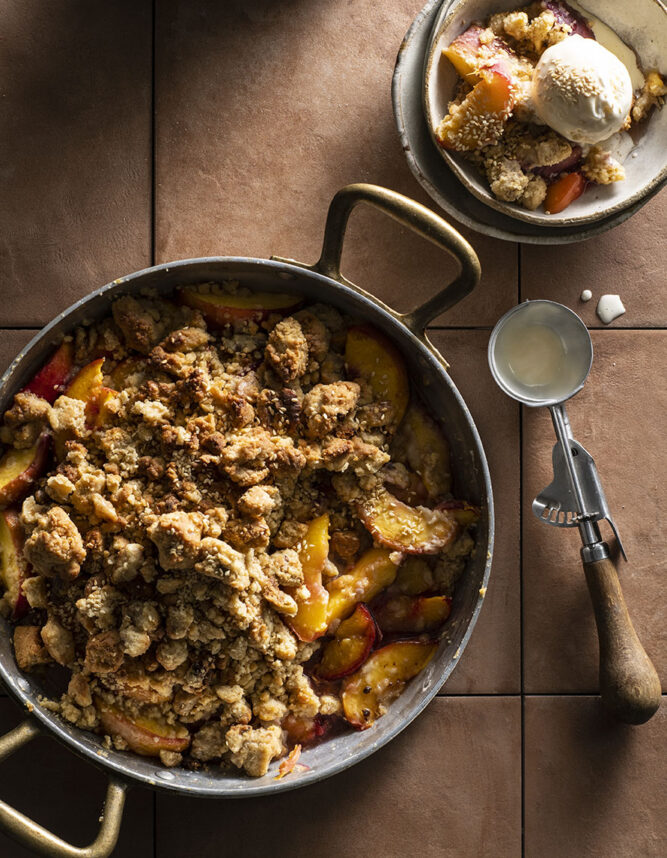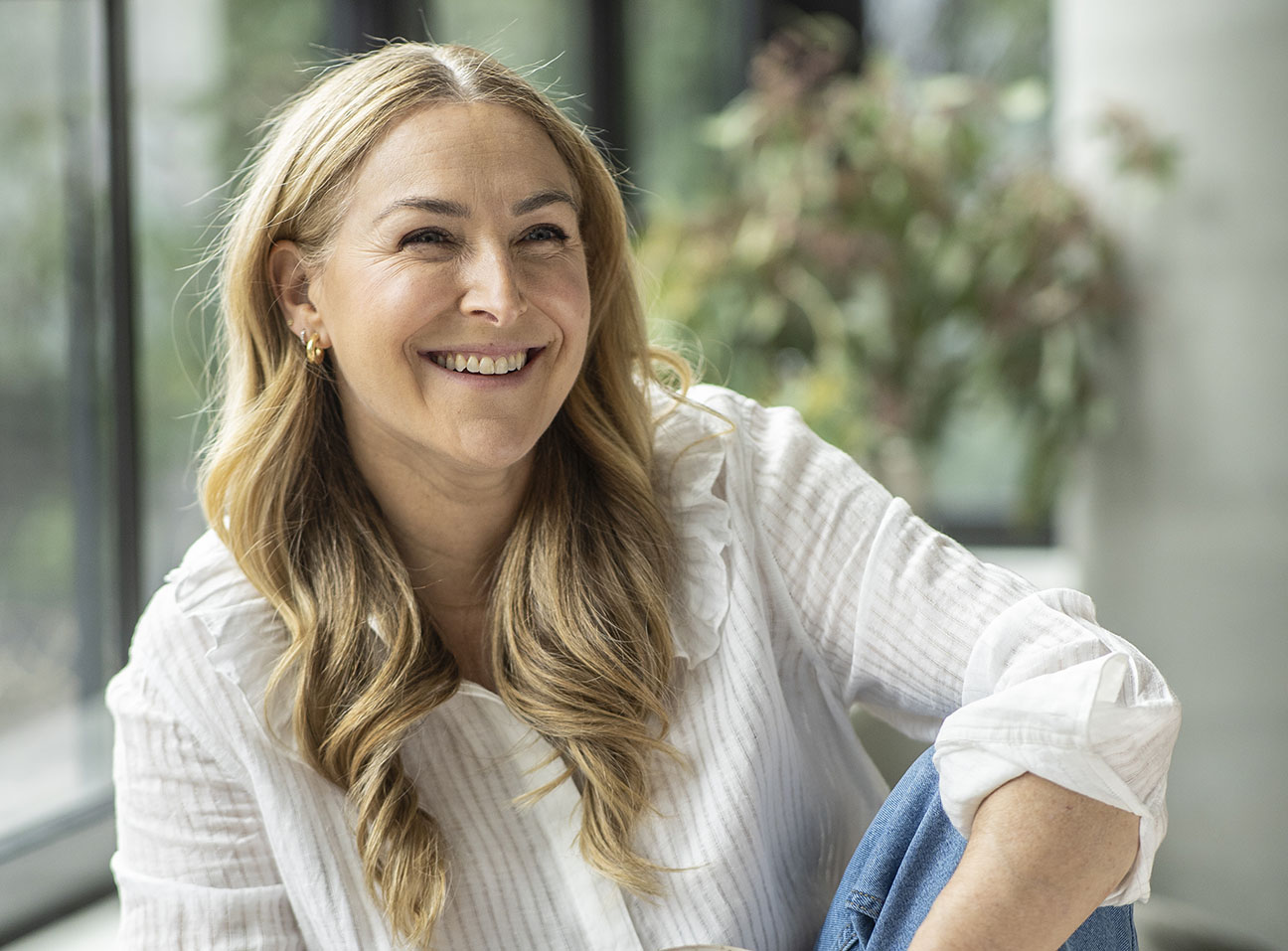Everything starts with a seed. Not just life, but vegetables, fruits, ideas and relationships
 Rachel Simons’ debut cookbook, “Sesame: Global Recipes + Stories of an Ancient Seed,” explores that metaphor through life, food, travel and history.
Rachel Simons’ debut cookbook, “Sesame: Global Recipes + Stories of an Ancient Seed,” explores that metaphor through life, food, travel and history.
For Simons, co-founder of popular tahini outfit Seed+Mill, based in New York City’s iconic Chelsea Market, seeds have taken her further than she ever could have imagined.
Simons moved to New York, where she met her Seed+Mill co-founders, Lisa and Monica, around 10 or so years ago. They were all at the second stages of their careers. Simons, who was in her late 30s and had lived in five different countries, figured she would be in New York for one or two years.
“We’d all lived overseas, were interested in food and cooking and entrepreneurship,” Simons told the Journal. “We saw an opportunity to open a business all around a product, mainly Tahini, that … was an underrated, underappreciated condiment or ingredient, and we wanted to throw our energy behind doing something fresh with it.”
Their little shop turned into a business – now nearly 10 years old – then a brand and eventually became a cookbook, inspired by a previously unknown need.
Simons said people come up to their counter, holding a jar of tahini, and asking for guidance and inspiration.
“They say to me, ‘I bought a jar of tahini a year ago because I wanted to make my own humus at home, but what else do I do with it [and] is it still okay for me to use it?’” Simons said. She replies, “Yes, you can use your jar of tahini; it lasts a lot longer than a year.”
“Sesame” answers that other question. It is a clear, approachable guide to the world of sesame, from halva and tahini to togarashi, gomasio and furikake. Whether it’s in the form of a seed, tahini (a ground sesame paste), sesame oil, or halva (a soft, fudge-like candy made from sesame paste), readers can incorporate it in 100 traditional and modern global recipes.
When asked if she always loved tahini, Simons admits that she hated it when she was growing up in Australia; it was not easy to find.
“The only tahini that I’d ever tried there was bitter,” she said. “”But I just didn’t realize that not all tahini and not all sesame is the same; it’s very similar to things like wine and chocolate and grapes and cocoa beans and all of those important commodities – you can get good or bad.”
The minute Simons tried really good tahini made from high quality premium sesame seeds, she was hooked: mind-blown, life changed.
“This time, 12 years ago, I was a lawyer, I was sitting at a desk, I was working with my family in Sydney, Australia,” she said. “I wasn’t particularly inspired or driven by the mission of what I was doing as a lawyer.
“Working in the food industry has a whole different set of challenges, but at least I am most happy when I’m in a kitchen, cooking for somebody, reading a cookbook, talking with a chef or learning about the origin story of a particular recipe or a type of cuisine.”
One of Simons’ favorite recipes is sesame and peach miso crumble. It’s easy to prepare, and comes complete with a food memory.
“My mom hosted Shabbat every Friday, and her favorite dessert was an apple crumble,” Simons said. “We often disagreed about the way she would make it versus the way I would make it, but this will forever remind me of my childhood growing up in Australia.”
Simon’s recipe is below.
“It’s essentially a lovely fruit-forward crumble,” she said. “The crispy, crumbly parts at the top are made with a very basic recipe of some sugar, flour, butter, but then I’ve added a twist of some sesame seeds, some tahini and some miso.”
She added, “The miso represents what I want with the book, which is to feel very global.”
The book starts with a poem that expresses the essence of the power of a seed.
In the beginning, it’s always a seed,
The first seed planted in a garden,
The first seed buried in a crack in the sidewalk,
The first seed of an idea.
And if that seed, if the elements are right, is destined to grow
How wild, how high, how fast, how fruitful is all yet to be determined.
But one thing is for sure, it will grow into something
A story to unfold.
Learn more at SeedandMill.com, follow @SeedandMill on Facebook and Instagram, and get a copy of “Sesame” at your favorite bookstore.
For the full conversation, listen to the podcast:
In my childhood home, mum would make an apple crumble for dessert every Friday night, and was very precise about her recipe. Even though the exact same dish arrived at the table every week for over a decade, it was always deliciously comforting and welcome each time. When I started a family of my own, I continued the tradition of making fruit crumbles, but I was far less focused on following a recipe and preferred to use it as an opportunity to throw whatever I have on hand in my pantry into the crumble topping. I always mix it by hand until I like the taste and the texture is somewhere in between not too dry and sandy and not too wet and soggy! I recently started adding miso to my crumble, which I think works beautifully with the sesame, and adds a unique flavor to an enduringly, classic dessert.

Serves: 6
Time: 1 hour and 15 minutes
Ingredients
2 ½ pounds ripe peaches (approximately 6 to 7), pitted and sliced
Juice and zest of 1 lemon
1 ½ tablespoons light brown sugar (optional: depending on how sweet your peaches are)
1 teaspoon cornstarch
1 tablespoon water
1 cup flour
1 cup sugar
½ cup walnuts, roughly chopped
½ cup unsalted butter, melted
⅓ cup tahini
⅓ cup sesame seeds
1 tablespoon white miso
1 ¼ teaspoons kosher salt
1 teaspoon toasted sesame oil
Ice cream or heavy cream, to serve
Directions
- Preheat the oven to 375°F.
- Place peaches in a baking dish (I typically use a 9-inch Le Creuset baking dish, but a 8-by-8-inch square baking dish will work).
Toss the peaches with the lemon juice and zest, and brown sugar, if using.
- In a small mixing bowl, use a fork to whisk the cornstarch and water. Add mixture to the peaches, toss gently until well combined, and set aside.
- In a medium bowl, add the flour, sugar, walnuts, melted butter, tahini, sesame seeds, miso, salt and sesame oil. Using your hands or a fork, mix until just incorporated and the mixture looks like wet sand, but holds together when pressed.
- Crumble topping over peaches, squeezing some of the topping into larger chunks and letting some remain loose and crumbly.
- Bake until the topping is golden brown and the peaches are fragrant and bubbling, approximately 1 hour. Check that the topping is not burning after about 20 minutes and cover with foil if necessary.
- Serve warm with ice cream or heavy cream.
Debra Eckerling is a writer for the Jewish Journal and the host of “Taste Buds with Deb.” Subscribe on YouTube or your favorite podcast platform. Email Debra: [email protected].




